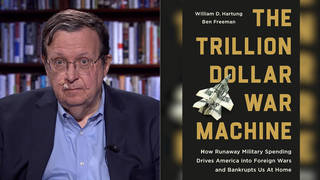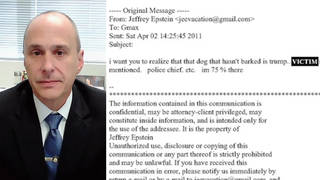
Topics
Guests
- Elizabeth JacobsonFormer loan officer at a Maryland branch of Wells Fargo. In June of this year, she submitted an affidavit in support of a federal lawsuit by the city of Baltimore against Wells Fargo. She now works in foreclosure defense.
Links
Up until two years ago, Elizabeth Jacobson was the top producing loan officer in the subprime division at Wells Fargo. Today she is speaking out against the practices of her former company. Earlier this summer, she filed a sworn affidavit with a federal court in support of the city of Baltimore’s lawsuit against Wells Fargo for pushing high-interest, subprime loans onto African Americans in Baltimore and the Maryland suburbs, leading hundreds into foreclosure. [includes rush transcript]
Transcript
JUAN GONZALEZ:
Wells Fargo was one of the top ten subprime lenders in the country and is among the top recipients of taxpayer-funded bailout money under the Home Affordable Modification Program. But it’s also at the receiving end of lawsuits accusing the bank of unfair and misleading lending practices to minority communities and what’s often known as “reverse red-lining.”
In January of 2008, the city of Baltimore sued Wells Fargo for a range of deceptive practices to push high-interest, subprime loans onto African Americans in Baltimore and in Maryland suburbs, leading hundreds into foreclosure.
This July, the Illinois Attorney General Lisa Madigan sued Wells Fargo for having, quote, “transformed our cities’ predominantly African-American and Latino neighborhoods, into ground zero for subprime lending.” In her statement, Madigan says, quote, “The dreams of many hardworking families have ended in foreclosure due to Wells Fargo’s illegal and unfair conduct.”
AMY GOODMAN:
In June of this year, two former Wells Fargo employees filed sworn affidavits with a federal court in support of the city of Baltimore’s lawsuit. They allege Wells Fargo targeted African Americans for subprime loans and routinely steered customers qualified for prime loans toward subprime loans.
We’re joined now from Washington, DC by one of the whistleblowers, Elizabeth Jacobson, a former loan officer turned sales manager at Wells Fargo from 1998 to 2007. She now works in foreclosure defense.
Welcome to Democracy Now!, Elizabeth Jacobson. Tell us your story. What did you do exactly at Wells Fargo, and when did you decide to blow the whistle?
ELIZABETH JACOBSON:
I was at Wells Fargo for nine years, and I originated loans. Wells Fargo had two separate divisions: the prime division and the subprime division. And you could not originate prime loans if you were in the subprime division. So that’s what I did for nine years at Wells Fargo, is originate the subprime loans.
In the beginning years at Wells Fargo when I started, there was no filter system. So, if you had somebody come into your office and you could sell them a subprime loan, even if they qualified for a prime loan, that’s what you did. The compensation worked out that you had a huge incentive to put people into a subprime loan. Even the prime loan officers would make as much money on a prime loan — or on a subprime loan, referring it over to the subprime division, that they would make doing a prime loan. So there was an incentive for the prime loan officers to refer the business to the subprime side.
And as a company, Wells Fargo pushed the subprime loans, because it was their goal to have the subprime division pay for the fixed costs of the whole company. So there were quotas to be met. People — Wells Fargo puts out this projection that when somebody walked into a Wells Fargo office, they got put in the loan that was best suited for them. What happened was, whoever happened to be the loan officer at that time would put them in the loan they felt was best for them, and usually that meant how much money they could make off of the loan.
JUAN GONZALEZ:
And what were the differences in the incentives for employees, in terms of putting someone in a subprime versus a prime loan?
ELIZABETH JACOBSON:
Well, just based on the commission, you would make sometimes three to four times as much in commission if you put somebody into a subprime loan. And you’d probably be thinking, well, why would somebody that perhaps had a really good credit score that could go prime end up in subprime?
So, when you looked at the initial rate, the teaser rate, on a 228 on a two-year arm, at that point the going rate may have been six, six-and-a-half percent, and that would be comparable to what was on the prime side. So when you got into the subprime loan, you’d have a similar rate, a similar payment. But in two years, that rate was going to adjust, and the first adjustment, it could increase by three percent up to nine percent, and then it could adjust by another three percent in another six months. So you’ve gone from six percent to 12 percent.
In addition, there was points on the loan. There could be two origination and two discount points. Generally, on a prime loan, the only reason you’d pay points is if you’re going to buy your rate down. But they were just selling payment. You just talked about what the payment was. And there were some loan officers out there that were just selling principal and interest payment, because on these subprime loans you did not have to escrow for taxes and insurance. Obviously, those payments had to be made, but the loan officer would get away with saying, “OK, this is your payment.”
And so, they’d be comparing it with other good-faith estimates of perhaps a prime loan, and they would actually think they were getting a better deal. In reality, they were not. And what would happen, as soon as they got to the table, things would switch. They might have thought they were in a thirty-year fixed, then all of a sudden they found out they were in a two-year arm.
AMY GOODMAN:
Elizabeth, talk about what changed you.
ELIZABETH JACOBSON:
Well, when I was hired by Wells Fargo, I had never worked in the mortgage industry at all. I had been a paralegal. So I took everything that Wells Fargo was telling me, that this is the way things were done. I didn’t question the fact that we were putting people in a 55 percent debt-to-income ratio and that we were only qualifying them based on the two years at the lower interest rate. The whole goal was, every two years you’re going to refinance that loan. So, it was sold as a two-year loan. These people were never intended to be in the loan for thirty years.
And as things started to happen in the economy, some time around in ’06, I could see that the guidelines were tightening up. And so, you’d question, well, why would they tighten up the guidelines if they said that they were doing responsible lending? They would — got rid of stated income loans at the lower credit scores. When I first started, you could get a stated income loan with a 520 credit score. So as things started to tighten up, and the response would always be, this is what the investors require. The investors are having trouble selling this loan, or people are defaulting on this loan, so they would internally tighten up the guidelines.
And then I just started to see, well, wait a minute, you know, we’re putting — we’re setting people up for failure, basically. And what really — the point that really made my decision that I was going to leave the company was third quarter of ’07. Wells Fargo was actually the number one subprime lender in the country. So, internally, we’re getting all these emails and all this information about “great job, we achieved our goal, we’re number one subprime lender in the country.”
And I happened to see a news report with the CFO of Wells Fargo, and he was questioned about the subprime division and denied at that point that Wells Fargo even had a subprime division. So here he is, the chief financial officer, where the subprime loans were supposed to be paying for the fixed costs of the company, and he’s denying that Wells Fargo even did subprime loans. That was just the final straw of total disillusionment, and then I put my resignation in.
AMY GOODMAN:
You were the head of the subprime division that he was denying existed?
ELIZABETH JACOBSON:
Right. Well, I was the top producer. I was originating approximately $55 million a year in subprime loans.
JUAN GONZALEZ:
And what about this whole issue that the city of Baltimore is raising about the targeting of minority communities, especially African American communities, by Wells Fargo? What was your experience in the question of who you were told to try to target for loans?
ELIZABETH JACOBSON:
A lot of this was information that I would receive on conference calls as a sales manager. And people on the call, the management there, would encourage the loan officers, the subprime loan officers, to go into Baltimore city and target the churches, the African American churches, to get a relationship going with the minister or the reverend at the church and try to get that person to schedule some sort of meeting. They would call it a “wealth-building seminar” to get the parishioners of the church to attend. And any loan that was funded by Wells Fargo, whether a purchase or a refinance, $350 would then be donated to the church. And so, that was the incentive for the church to want to have these seminars there.
But what would happen is the only loan officers that would attend these seminars were generally the subprime loan officers. And on these conference calls, at one point, somebody made a joke who happened to be a white loan officer and said, “Well, will I be able to go to these seminars?” And they were told right there on the conference call, unless you were of color, you could not attend these conferences, these wealth-building conferences. So it seemed me — Wells Fargo didn’t come right out and say this; this is just what I saw — is that they wanted the African American Wells Fargo loan officers to sell loans to the African American community.
JUAN GONZALEZ:
And you’re saying that the churches were getting, in essence, a finder’s fee for $350 for every one of their church members who ended up getting a loan?
ELIZABETH JACOBSON:
Correct. Wells Fargo did this under a program where they would donate for any homeowner $350 to the nonprofit of their choice. So I don’t want to — for this to imply that it was only the churches. So, anybody that got a loan at Wells Fargo could ask that the $350 be donated to any nonprofit. But the way that it was sold to these churches was, well, that money then will go back to your church. Have the parishioner decide, as the church is a nonprofit, that they want that $350 to go right back to that church.
AMY GOODMAN:
I want to turn to a clip from a new documentary about the subprime crisis that opens in New York next week. It’s called American Casino. It’s directed by Andrew and Leslie Cockburn. This clip shows the Baltimore-based Reverend Almalene “Emily” Wade, who lost her home.
REV. ALMALENE ”EMILY” WADE: I’m homeless. And it’s just hard. It’s a struggle. It’s devastating. It’s upsetting. It’s unbelievable. But it’s real. I don’t have a home anymore, and I’ll never forget this as long as I live.
This is a house that I grew up in most of my life. I came here in 1961 with my mother and my father. I’ve been here a lifetime. And I went to school here. I went to junior high school, went to high school, went to college. And we used to have a church next door, and the neighborhood was just home. This was just home.
I wanted to do a assisted living here. I wanted to help people. And the property wasn’t in the proper condition that it needed to be, so I was advised to take the equity out of the property, some of the equity, and do a loan and start my project that way.
The loan was for $28,000. It’s really sad that all of this was lost over $28,000. The monthly payments was close to like $300 a month, but I was on a fixed income, and it was just — it just got to be too much. Wells Fargo was the mortgage servicer, and that’s who serviced my loan and who I got the loan through. I really, at that particular time, didn’t know all the ins and out of a mortgage loan. I just took it by faith that I was going to be OK.
Settlement was really fast. You just don’t know. You know, you’re trusting your mortgage broker. You’re trusting the settlement people. You’re trusting the bank. And what else can you do? You really don’t have a clue. You’re just happy to have someone say, “Yes, we will finance you. Yes, you are approved. Yes, you can go to settlement.”
AMY GOODMAN:
That’s an excerpt of American Casino, the story of the people who are foreclosed on.
Finally, Elizabeth, you talk about the joke in the office being that selling these, pushing these subprime loans as being “riding the stagecoach to hell.” Well, now you’re off that stagecoach, and you’re doing foreclosure defense?
ELIZABETH JACOBSON:
Correct. I’m working with several attorneys in the state of Maryland. And most of these people that we’re seeing come in were put into predatory loans, and these loans were sold as mortgage-backed securities. Most people have no idea who actually owns their loan. Wells Fargo could service it, Chase could service it, Bank of America could service the loan, and people tend to think that that’s who owns their loan. So they get the foreclosure filing, and what we do is ask them to produce the note to prove that they actually own the loan, because there’s — most cases, there is no chain of custody of the note. And in Maryland, there’s no requirement to produce the original note.
So we’re trying to put up that defense. We’re trying to get the word out there. Very few people realize they could possibly have a defense. And there’s some defenses out there that are just rather technical. The plaintiff that’s filing the foreclosure doesn’t follow the law. They’ll put one entity down on the notice of intent to foreclose as a secured party. Then, when they file the order to docket, which is the instrument that’s filed in the circuit court, it will list a totally different company.
And what happens is, unless the homeowner puts up some sort of defense, these are all rubber-stamped. Maryland is a non-judicial state. It just goes through the system. So these plaintiffs’ attorneys can basically put whatever they want in these documents, and the judge isn’t going to look at it, unless the homeowner says, “Wait a minute, let’s put up some sort of defense.”
And I’m also finding, in helping people doing these defenses, and actually through loan modifications, part of HAMP is that you are to stop all foreclosure proceedings, including, of course, the sale of the house, if a homeowner has applied for HAMP. They don’t even have to be approved for HAMP. Just the application for HAMP. And that’s not known out there. So there’s a lot of benefits, obviously, going with the HAMP program, but the lenders will still move forward with a foreclosure, even if you’ve applied under HAMP, which is prohibited.
AMY GOODMAN:
Well, we’re going to leave it there. Elizabeth Jacobson, thank you very much for joining us and for coming out.
ELIZABETH JACOBSON:
Thank you.
AMY GOODMAN:
As being a top loan officer, subprime loan officer, at Wells Fargo. In June of this year, she submitted an affidavit in support of a federal lawsuit in the city of Baltimore against Wells Fargo. She now works in foreclosure defense.












Media Options